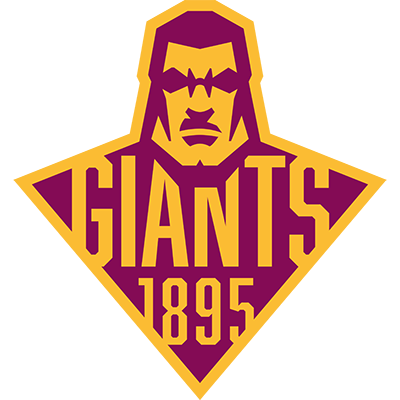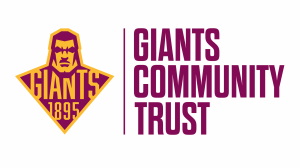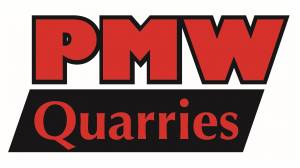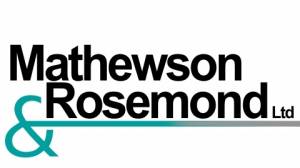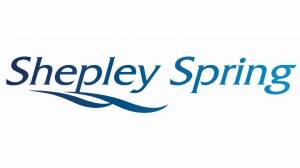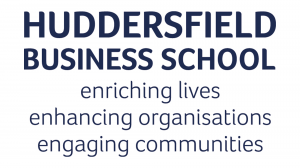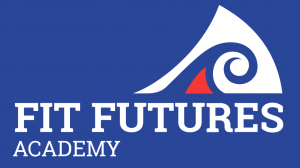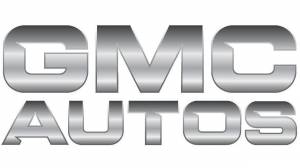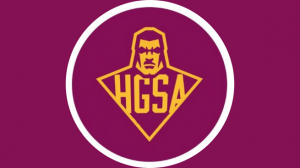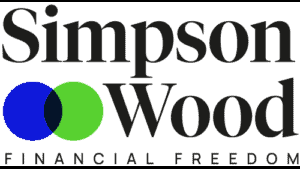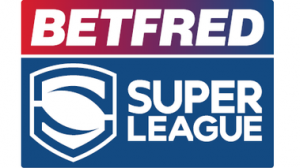Club History
CLUB HISTORY
On 10th February 2008, the Giants attracted the biggest crowd for 40 years as they fell to an opening-weekend 30-10 defeat by Leeds Rhinos - the 15,629 crowd eclipsing the club’s previous best Super League attendance of 12,417 in 1998.
On 15th May 2008, the vastly-experienced Wests Tigers full back Brett Hodgson signed a two-year contract to play for the Giants in 2009.
Meanwhile results were not going the way they should have for Huddersfield, subsequently on 2 June, Jon Sharp became the third Super League coach within a fortnight to be sacked, assistants Paul Anderson and Kieron Purtill taking temporary charge, and on 18th July 2008 Nathan Brown, previously with St George Illawarra, was appointed new head coach for 2009.
Other new faces at the Galpharm were hooker Scott Moore (on a season-long loan from St Helens) and Workington hooker Shaun Lunt.
After a mediocre 2008, with the Giants finishing third-bottom of the League, season 2009 saw a complete turn-round in the fortunes of the club.
Huddersfield finished in third position - a Super League best - after a resounding 48-16 win over Wigan Warriors at the Galpharm Stadium, with Brett Hodgson the inspiration behind the success, seemingly omnipresent in attack and defence and slotting eight immaculate conversions from all over the pitch.
Hodgson had a tremendous first season (15 tries, 98 goals) - he was voted by his peers as Super League Man of Steel, won the Rugby League Writers’ Association Player of the Season and was selected in the Super League Dream Team.
Not to be outdone, Scott Moore played for England against France in Paris on 13th June, as well as England’s Four Nations game against the same team in October - Eorl Crabtree also earning representation in Tony Smith’s England squad.
Moore was also selected in the 2009 Super League Dream Team.
It got even better for the Giants. After a magnificent 24-14 Challenge Cup Semi-Final win against St Helens at Knowsley Road, the Giants took on Warrington Wolves at Wembley Stadium on 29th August 2009.
Huddersfield were never allowed to settle after failing to produce the sort of performances that had made them a major force throughout the season, Warrington winning by 25-16.
Again, there was disappointment in the Play-Offs, the Giants losing both their qualifying games against St Helens and Catalans Dragons, however, Huddersfield’s determination over the season earned Nathan Brown the accolade as Super League Coach of the Year, with the Giants’ efforts off the field earning them the honour of Super League Club of the Year.
Close season acquisitions included Wakefield Trinity Wildcats utility back Scott Grix and South Sydney back-rower David Fa’alogo, with Danny Brough arriving mid-season from Wakefield.
In 2010, Huddersfield Giants came within one game of the Grand Final, and captain Brett Hodgson revealed he would be signing for Warrington at the end of Super League XV.
Another unwanted shock during the season was that coach Nathan Brown announced he was returning home after two years into his three-year contract, but then changed his mind.
The Giants’ play-off run from fifth spot and the selection of six players - Kevin Brown, Leroy Cudjoe, Eorl Crabtree, Darrell Griffin, Shaun Lunt and Luke Robinson - in England’s Four Nations Squad meant the season finished on a major high.
2011 was a year of ups and downs, with Huddersfield Giants, among the leaders for much of the year, frustratingly erratic - the season tailing off ending in a 47-0 thrashing at Warrington in the Play-Offs, and then elimination at the Galpharm, going down 38-24 to Leeds Rhinos.
Nathan Brown, linked with coaching vacancies in the NRL mid-May, committed his short-term future to the club by signing a 12-month contract extension to stay with the club until the end of 2012.
Added to the playing staff for 2012 were Jason Chan, a Papua New Guinea forward signed from defunct club Crusaders, utility player Tommy Lee, and young backs Luke George and Aaron Murphy from Wakefield Trinity Wildcats, plus Castleford Tigers threequarter Greg Eden.
Injuries to several key players at the beginning of 2012 meant Nathan Brown had to ‘blood’ some of the younger squad members who had little Super League experience including Jacob Fairbank and Adam Walker.
Huddersfield shrugged off the absence of seven first-choice players to pull off a 20-16 opening-round win over Wigan Warriors at the DW Stadium on 5th February 2012.
The Giants were lacking six regulars through injury and new signing Tony Tonks to suspension, but knocked Wigan off their stride from the kick-off and thoroughly deserved their victory.
The following week newcomers to Super League, Widnes Vikings, were the visitors to the Galpharm for the Giants first home match of the season - a scoreline of 66-6 in favour of the Giants made it the highest winning margin (60pts) in a Super League game by Huddersfield.
Leroy Cudjoe scored four of the Giants’ tries to equal the record for most tries in a Super League game for Huddersfield - Chris Thorman had previously scored four against Leigh Centurions back in 2005.
Picture: Challenge Cup Final 2009

After a nightmare start to 2003 in which the Giants crashed out of the Challenge Cup at Hunslet, they slowly but surely began to establish themselves as Super League calibre by winning at home to reigning champions St Helens, and by the end of the season Leeds, Wigan, Hull and Widnes had also been beaten as Smith watched his side secure a club record eleven Super League wins for the season, plus a draw against Widnes.
Smith had succeeded where other coaches had failed in keeping the Giants in Super League, but that attracted the attention of Leeds Rhinos who recognised Smith’s huge talent, moving on to take control at Headingley.
St Helens assistant coach and former Hull forward Jon Sharp was appointed head coach for 2004 and the team improved again, finishing seventh in the League and reaching the Challenge Cup semi-finals for the first time since 1971.
The Giants continued to recruit - the talismanic Brad Drew joined the club from Canberra Raiders in June 2004, and was an ever-present during 2005.
The following month high-profile signing Michael De Vere, the Australian Test centre from Brisbane Broncos, was signed in readiness for the 2005 season.
In the home game with Leigh Centurions on 21st August 2005, the Giants recorded a 68-16 win, Chris Thorman scoring 36 points comprising 4 tries and 10 goals to set Huddersfield Super League match records of most tries, goals and points.
For the kick-off of the 2006 season the club unveiled a host of new signings to strengthen the squad, including the iconic New Zealand international scrum-half Robbie Paul from Bradford Bulls.
After a convincing 44-14 victory over Salford in the quarter-final of the Challenge Cup, the Giants faced Leeds Rhinos (coached by Tony Smith) in the semi-final at Odsal Stadium on 30 July, and against all the odds Huddersfield pulled off a magnificent 30-12 win, with Stuart Donlan and Chris Nero scoring two tries apiece, Michael De Vere adding a try and five goals.
In their first Challenge Cup Final for 44 years, the Giants threatened to pull off one of the greatest upsets in Cup Final history when they led 6-0 after twenty minutes, however, it was not to be as Huddersfield were eventually beaten 42-12 by red-hot favourites St Helens at Twickenham on 26 August 2006.
Saints turned the screw and, though the Giants rallied in the final quarter, the contest was over.
The team that represented Huddersfield was:
Paul Reilly: Martin Aspinwall, Michael De Vere, Chris Nero, Stuart Donlan: Chris Thorman, Robbie Paul: Paul Jackson, Brad Drew, Jim Gannon, Eorl Crabtree, Andy Raleigh, Stephen Wild
Subs: Steve Snitch, Stuart Jones, Paul Smith, Wayne McDonald
The start of the 2007 season saw the Giants add Wests Tigers trio Jamahl Lolesi, John Skandalis and Shane Elford to the playing staff, but the season started horrendously for the Giants, losing their first seven games.
By April, finally it all came good as they hammered table-topping Wakefield Trinity Wildcats 56-12 at the Galpharm Stadium on Good Friday.
By the end of May the picture was totally different.
The Giants had a Challenge Cup quarter-final to look forward to and had successfully been on their longest-ever winning streak since joining Super League (nine games, including two in the Challenge Cup) - in addition, Sharp was named consecutively as Coach of the Month for April and May.
The Huddersfield revival continued and by the end of the season had finished fifth in Super League and reached the Play-Offs for the first time after a nail-biting 24-22 home win over Wakefield, however, on 22nd September a 22-16 defeat at Hull ended the campaign, with end-of-season departures Paul Reilly, Brad Drew and Chris Nero confirmed.
It was also a good year for the ever-consistent Stephen Wild.
Picture: Twickenham, 26 August 2006. Huddersfield's Brad Drew moves in to tackle Jayson Cayless of St Helens in the Powergen Challenge Cup Final

It had been a great season and the proposed inclusion into Super League was an added bonus.
In 1998, due to the collapse of Paris St Germain, Huddersfield were admitted into Super League despite not winning the Division One title.
Huddersfield opened their first season in Super League with their biggest home League attendance (12,417) for thirty-six years, but the 38-6 defeat against Bradford Bulls on 3rd April 1998 was a warning of what was to follow.
They finished with only two victories - the worst record in Super League history: other unwanted Super League records were the run of thirteen successive defeats and the most points conceded in a home match when they lost 72-16 to Leeds.
Gary Schofield, in his first season as coach, and lacking the necessary coaching qualifications, was the only one not to complete the season, Phil Veivers became temporary coach until the end of the season, with Malcolm Reilly taking over for 1999.
On 30th September 1999, Ken Davy announced that the Giants were to merge with Sheffield Eagles to form a new Super League club, with Sheffield Eagles continuing in the Northern Ford Premiership.
John Kear took over as head coach of the merged side, however, the Association of Premiership Clubs blocked proposals for a separate Huddersfield team in the NFP.
The team were officially known as the Huddersfield-Sheffield Giants with the intention to play a quota of games at Sheffield United’s Bramall Lane ground.
Many Huddersfield supporters remained sceptical about having the name ‘Sheffield’ in the title, and over two hundred loyal Fartown fans marched through Huddersfield to demonstrate against the merger.
This arrangement lasted only a season, and on 7th September 2000, ‘Sheffield’ disappeared from the title of the McAlpine Super League club.
With the club conducting interviews for John Kear’s successor in the summer of 2000, it emerged that a little-known Australian, Tony Smith, had paid his own air fare to fly over and join the process, and within days had been installed as head coach for the 2001 season.
Yet it wasn’t long before hopes were being shattered.
With a squad Smith had largely inherited and, having lost the opening seventeen Super League games, Smith’s future looked uncertain, but the Giants board kept faith with their man and in the 18th game of the season, the Giants picked up their first point with a late 22-22 draw against London Broncos.
Huddersfield went on to win six of their last nine games, unfortunately Wakefield’s away win against Salford on the last day of the season meant the Giants were relegated by one point and having to prepare for life in the Northern Ford Premiership.
Smith decided to stay on, the Giants board backing him by retaining a predominantly full-time squad.
The decision paid off as the club went unbeaten for the entire 2001-2002 League season, drawing only one match (against Whitehaven 12-12 at the Recreation Ground) and winning 26 of their 27 league games.
Smith’s side swept all before them in clinching the mid-season Buddies National League Cup beating Hull KR in the final at Featherstone Rovers on 26 May 2002, and then went on to secure the Minor Premiership.
In the NFP Grand Final at Widnes on 12 October 2002, they beat nearest rivals Leigh Centurions 38-16, thus ensuring promotion back to Super League for the 2003 season.
It was just reward for Smith, who was voted Coach of the Year, and his outstanding squad of players.
Picture: NFP League Winners

Huddersfield took a share in the new McAlpine Stadium (now known as the John Smith's Stadium), with the first game against Barrow on 21st August 1994 resulting in a 50-12 win.
Just when supporters thought the season was over, marvellous performances in the Play-Offs against Rochdale Hornets (36-10) and Batley (13-6) swept Huddersfield to the Second Division Premiership Final at Old Trafford, Manchester, on 21st May 1995 - their first major final for 33 years, however, the day ended in disappointment as Keighley Cougars emerged victors 26-6.
In the play-off game against Rochdale Hornets at Fartown, Huddersfield’s Australian centre Greg Austin registered a 52nd try to equal the record for a centre in a season set by Paul Newlove in 1992-93.
Super League and its ramifications hit Britain early in April 1996, causing the biggest upheaval and controversy in the game’s history, but it had started months earlier in Australia with the power struggle between media moguls Kerry Packer and Rupert Murdoch as they battled for television rights for the Winfield Cup.
Rarely can two eras of sport have been so dramatically linked as those which saw Rugby League’s Centenary Season being followed by the first Super League and summer rugby campaign, but it would be another two years before Huddersfield rose again to the top level of the game.
In 1996, Ken Davy took over as Chairman of Huddersfield and ‘Giants’ was added to the team name.
Davy was initially involved with the club when his independent finance company DBS Management began to sponsor the club.
Huddersfield, on low gates and high match costs, were like many other rugby clubs of the pre-Murdoch era.
Within two years of this sponsorship deal, clearly the Giants were in financial trouble.
Davy decided to get more involved and took control of the Huddersfield club, and with him at the helm top-name coaches were acquired and high-profile signings were made, resulting in a winning formula and dramatic increase in the Giants supporter base.
In 1997, Huddersfield Giants upset the form book when they defeated Division One champions Hull Sharks 18-0 in the Stones Divisional Championship Premiership Final at Old Trafford on 27th September - led by Phil Veivers and the class of Craig Weston who took the man-of-the-match award, plus a superb all-round defensive performance from the whole squad.
The Huddersfield team that day was:
Team: Phil Veivers (capt): Paul Cook, James Bunyan, Dean Hanger, Andy Cheetham: Craig Weston, Ali Davys: Neil Harmon, Danny Russell, Nick Fozzard, Tony Bowes, Dave King, Matt Sturm.
Interchange: Basil Richards, Joe Berry, Steve Booth, Paul Dixon.

Rugby League was to experience substantial growth outside the North of England in the 1990’s.
That growth, which took the membership back to 36 clubs for the first time in 80 years, necessitated the adoption in May 1994 of a geographical fixture formula for the Second Division.
As membership fluctuated that formula was employed or dropped until it was decided to create a Third Division on 17th April 1991.
The first season of the Nineties saw Huddersfield finish mid-table in the Second Division, but not without change.
In February 1991, Barry Seabourne was replaced by joint-coaches Mick Blacker and Frannie Jarvis.
Almost immediately into the start of Huddersfield’s 1991-92 Third Division campaign, Blacker and Jarvis were relieved of their coaching duties and the Fartowners reaped swift reward for some off-field enterprise in appointing Alex Murphy as their team manager.
The master-stroke of appointing Murphy as assistant Terry Flanagan turned a disappointing start into the most successful season for seventeen years as they steered Huddersfield to the Third Division crown.
The Fartowners had long been in the wilderness, but at last they were on the way back - Murphy had worked his magic once more.
The Club were forced out of their ground in 1992, and ground-sharing with Huddersfield Town was a necessity for two seasons.
The final first team game was against York in the John Smiths Yorkshire Cup Preliminary Round on Sunday 23rd August 1992 ending in a 36-12 win - it was the first game of the 1992-93 season and the last for the senior side at Fartown.
The unthinkable had happened - there was no fanfare, no formal curtain call.
It was with a certain amount of resignation on 30th August 1992 that the Fartowners moved to Leeds Road.
For the first game at Leeds Road, a turn-out of 2,907 watched the Second Division match against Featherstone Rovers, however, attendances dipped, averaging 1,985 in 1992-93 (rising to 2,227 in 1993-94), but the familiarity of the eight-club Second Division format coupled with Huddersfield’s poor start were acceptable explanations.
A revival in league fortunes - a five-match unbeaten run earning Huddersfield the title of November Team of the Month - enabled them to finish 1992-93 a highly creditable third in the table, missing out on promotion by just one place.
Huddersfield did actually win some silverware - the Alex Angel Trophy at the Olympic Stadium, Barcelona, against XIII Catalan on 30th May 1993.
The game was unofficially billed as the ‘European Championship’ and was the climax of the Fartowners eleven-day tour in France.
Six teams were invited to take part in the competition, consisting of Tiraspol and Moscow Magicians (Russia), Carcassonne and Trieze Catalan (France), plus Batley and Huddersfield.
The final was a thrilling affair, Brad Davies landing a late drop goal to give Huddersfield a 23-22 victory.
Further restructuring saw two divisions re-introduced for the 1993-94 season.
After a promising start Huddersfield and joint-favourites Keighley Cougars both faded in the run-in to finish outside the top four.
The slump followed further revelations about the financial state of Fartown as the club, more noted for making headlines off the pitch than on it, hit more turbulence.
Chairman Mick Murphy, who had taken over the reins when Joe Bramley resigned in acrimonious circumstances in mid-season, revealed that debts had reached almost £500,000 and in May 1994 called for an administrator to find a buyer for the club.
The season ended with the final game at Leeds Road on Thursday 21st April 1994 (to avoid a clash with Huddersfield Town’s Autoglass Trophy Final at Wembley) - Huddersfield losing 28-12 against Dewsbury, to bring to an end a brief yet eventful two-year stay at Leeds Road.
More significantly, it paved the way for a ground-sharing scheme that became the envy of rugby league.

Season 1984-85 was a further year of struggle for the club - Brian Lockwood was replaced as coach by Chris Forster, though crowds rose to 905.
At end of the season all sports fans were shocked by the tragic fire on 11th May 1985 at Bradford City’s Valley Parade ground when 56 lives were lost.
There were resounding repercussions for rugby league grounds whose facilities came under the Safety of Sports Grounds Act, as many were in advanced states of decay, none more so than the crumbling Fartown complex.
Its impact on rugby league was financially devastating, as it forced clubs to confront the legacy of neglect of their grounds, however, it was a ‘catch 22’ situation as insurers raised fire and storm premiums paid by the clubs to astronomical levels.
Further depression set in at Huddersfield in 1985-86 as only 303 spectators (Huddersfield’s lowest-ever crowd)) turned up at Fartown on 17 April 1986 to see an amazing 32-32 draw with Keighley - to complete a thoroughly miserable year the club’s average attendance plummeted to 678.
On 11th May 1986, Trevor Leathley played his final game for Huddersfield against Blackpool Borough - a master of the interception try, showing extraordinary anticipation and a remarkable turn of speed in setting up tries, Leathley had shown a wonderful record of consistency in his thirteen years with Huddersfield (320 + 23 sub games, 110 tries).
Season 1986-87 started with a new ray of hope, much was promised with the expensive signings of ball-playing forward Tony Kinsey from Fulham and record-breaking goal kicker Steve Hesford from Warrington, sadly neither investment was to pay off.
Problems continued off the field, or rather round it, safety regulations threatened to cause the ground to be ‘standing room only’, both stands being barred to paying spectators.
A short-term reprieve was granted, limiting 300 in the Main Stand until storm damage caused that too to be closed for a considerable period.
Christmas saw the departure of coach Chris Forster, with chairman John Bailey offering to surrender control of rugby at Fartown whilst appointing Jack Addy as coach, the season ending with a double defeat against Dewsbury - the Huddersfield Examiner declaring ‘ This was one of the worst, a shameful end to the Arena season’.
The Fartown faithful were once again condemned to ‘standing room only’ in 1987-88, no work having been done to bring the stand up to the required safety regulations.
A council loan was proposed, but then local businessman Jim Collins made his first takeover bid for the club, however, the proposed loan of £25,000 from the local authorities to assist with refurbishment was blocked by a council sub-committee.
Politics took over as the council’s loan was re-offered under ‘certain terms’, with John Bailey blocking Jim Collins’ attempt to buy shares.
After a further slump in the team’s fortunes, Jack Addy resigned as coach with Neil Whittaker and St Helens-based Allan Jones appointed to finish the season out.
A glimmer of hope occurred in 1988-89, the universally disliked ‘Barracudas’ tag was abandoned, with John Bailey offering to ‘give the club away’ to anyone who would take on the responsibility of running the team, improving the ground and being responsible for the necessary work to retain a safety certificate.
Enquiries were made by a number of interested parties, among them Mick Murphy, Jim Collins and lifelong Fartown supporter Neil Shuttleworth.
The three-man consortium finally took over rugby activities in November 1988, with Nigel Stephenson as coach.
A portion of the Main Stand was re-opened and refurbishment made to floodlighting, with Rugby League officials visiting the ground to ensure there were genuine plans for the future.
One player to leave the club was prop forward Jimmy Johnson - signed in December 1977, Johnson had remained loyal to Huddersfield in view of the lean times experienced by the club.
He played 264 +21 sub games, scoring 48 tries and a drop goal, his last game was against Batley on 12 March 1989.
In readiness for the 1989-90 season, a tremendous amount of work was carried out on the ground during the summer months, including a fully-refurbished scoreboard, repairs to the famous terrace-side, new goal posts and extended seating in the Main Stand - the club was beginning to show pride once again.
In August 1989, a previously unknown twenty-two year old Australian named Wally Gibson burst onto the scene, making his debut at Whitehaven and scoring an incredible hat-trick of tries, however, the economics of Second Division rugby kicked in with Anthony Farrell sold to Sheffield Eagles in a record deal of £55,000, which supported the clubs’ finances for the remainder of the season.
Pictured: Huddersfield 1988-89
From left: Back Row:
Mick Blacker (Asst Coach), Huck, Diskin, Simpson, Brooke, Kenworthy, Boothroyd, Subritzky, Power, Nigel Stephenson (Coach)
Front Row:
Cocker, Senior, Thomas, Gibson, Farrell, Lee St Hilaire, Shuttleworth, McIntosh, Phil Johnson (‘A’ Team Coach)

The 1980s must have represented the most miserable and traumatic time in the whole history of Huddersfield Rugby League Club.
Coaches were to come and go, new talent was unearthed only to pay off the bills.
From decades when local talent signing for Huddersfield could be counted on one hand, the 80’s opened a flood gate.
The 1980s witnessed fundamental changes in many areas.
Sponsorship quietly making its appearance in the 1970's, became perhaps the most important determinant of the game.
Two competitions disappeared during the decade - the County Championship, born in 1895 ceased to be in 1982, the Yorkshire Senior Competition and Lancashire Combination for reserve teams were abandoned in 1984.
On the playing field, 1983-84 was one of great watersheds for the sport, the sin-bin was introduced allowing referees an alternative to dismissing players, also the four-point try was adopted which drastically raised scores in matches and made past records redundant, and in 1983 a handover of the ball to the opposition side, rather than a scrum, was introduced when the attacking side was tackled on the sixth-tackle - as a result, making the game faster than ever and demanding more athleticism from the players.
Huddersfield began season 1981-82 under the direction of coach Les Sheard and saw the club finish eleventh in the Second Division with crowds averaging 1,185.
The following season (1982-83) was equally mediocre, crowds slumped to an alarming average of 776.
The club finished twelfth position in the league and during the season coach Les Sheard was replaced by David Mortimer.
In season 1983-84, Chairman Roy Brook had been in negotiation with a new consortium who wished to buy Huddersfield Cricket and Athletic Club, but on 18th August 1983 new chairman John Bailey, John Hillam and Graham Ramsden joined forces with the existing board as new directors.
Events quickly led to the resignation of David Mortimer which was followed by the equally surprising appointment of director Mel Bedford.
Picture: Huddersfield 1983-84
From left to right:
Back:
Wilson, Thomas, Davies Murray, Cramp, Johnson, Fitzpatrick, Rose, Leary (Physiotherapist)
Front:
Punter, Barton, Wroe, Leathley, Blacker, Senior, Bostock

Another change involved the value of a drop goal from two points to one in 1974 - this and the introduction of the differential penalty at the scrum in 1976 led to a drastic reduction in the number of goals kicked.
The days of the Top Sixteen Play-Off were also numbered, and in 1973-74 clubs decided for the third time to give two divisions a whirl - unlike the previous two short-lived experiments, the two division set up this time endured.
Huddersfield found themselves in the Second Division after finishing in 24th position in 1972-73.
After finishing the 1973-74 Second Division season in tenth place, 1974-75 was a good one for the Fartowners as they finished the season as Second Division Champions, robbing the title from under the noses of Hull KR.
Brian Smith, the coach, together with the signings of Castleford pair Glen Knight and Tony Miller, transformed Huddersfield into a powerful Second Division outfit, helped by John Hartley who kicked 110 goals.
What the side lacked in polish they made up for in endeavour and a great team spirit, however, after just one season in the First Division they found themselves relegated after languishing at the foot of the table for most of the season.
An astute signing, albeit for one season only, was that of Neil Fox as player/coach in 1977-78.
Under Fox’s guidance, Huddersfield finished the season in fourth place achieving promotion to the First Division, and whilst with the club Fox overtook Jim Sullivan’s all-time points scoring record which had stood since 1946 on 2nd January 1978 with the third of his four goals for Huddersfield in a win over Oldham.
Again in 1978-79, Huddersfield found the going tough in the First Division and were relegated after finishing bottom of the league.
One consolation was that the club celebrated 100 years of football at Fartown when Hubert Pogson turned the clock back sixty years and kicked off the First Division game between Huddersfield and Wakefield Trinity on 29th October 1978.

After sixty-two years, 1970 saw the last of the Lancashire and Yorkshire League Championships, clubs soon had a replacement at which to aim for in 1971-72 when the John Player Trophy was instigated.
On 3rd April 1971, Huddersfield reached the semi-final of the Challenge Cup against Leigh at Wigan, again fate taking a hand as the Fartowners were defeated 10-4 in a try-less game.
Another stalwart of the club retired in April 1971: Don Close was one of the outstanding hookers in the rugby league game during the post-war era.
A player who gave 100% for the Fartowners, he was a fair striker for the ball, quick and had the true virtue of all the best hookers - possessing the knack of getting the ball, not from every scrum, but getting it when it was wanted.
Close joined Huddersfield from Allerton Bywater ARL in 1957 and played 408 times (7 tries), he played once for Great Britain against France in 1967, and won seven Yorkshire caps.
In the early Seventies, Huddersfield created a record by signing four brothers - Jim, Trevor, Brian and Ronnie Doyle - and also brought Greg Veivers and Wayne Bennett over from Australia to play for most of the 1972-73 season, after which Veivers returned to Australia and captained their national side, Bennett going on to earn world-wide fame as coach to Premiership winners Brisbane Broncos, Queensland and Australia.
For many years kicking in loose play had bordered on criminal and the drop goal had become something remembered but not practiced.
Limited tackles allowed teams to devise completely new strategies within the four-tackle format.
Suddenly kicking once again became essential - to be caught in possession on the fourth tackle resulted in a scrum, more scrums were something nobody needed, consequently by 1972 the rule was extended to six tackles.
Pictured: Don Close

The 1967-68 season saw Huddersfield taking another step to once again becoming a leading figure in rugby league with the installation of floodlights.
The floodlights were officially switched on by the President of Huddersfield C & AC, Mr Robert Hanson, before the game against Hull on 18th October 1967.
In a classic Challenge Cup first round tie at Knowsley Road on 3rd February 1968, Huddersfield upset the form book by defeating St Helens 5-0, going on to beat Halifax and Featherstone Rovers and progress to the semi-finals, however, in a scoreless game against Wakefield Trinity at Odsal Stadium on 30th March, Trinity went on to win the replay 15-10 the following Wednesday.
For the first time in 1969-70, two substitutes were allowed at any time, instead of only up to half-time as previously.
As Huddersfield moved into the Seventies, Hubert Lockwood was elected Vice-Chairman of the Rugby League Council, becoming Chairman between 1970 and 1972, uniquely emulating his father Richard who held the position in 1945-46, the game’s fiftieth anniversary.
It was the first time a father and son had held the highest office in the game.
Hubert served for twenty-six years on the committee at Huddersfield, becoming Chairman of the club in 1955, and in 1962 was elected Chairman of the Yorkshire Senior Competition.
In 1975 he was made a Life Member of the Rugby Football League.
After sixty-two years, 1970 saw the last of the Lancashire and Yorkshire League Championships, clubs soon had a replacement at which to aim for in 1971-72 when the John Player Trophy was instigated.
On 3rd April 1971, Huddersfield reached the semi-final of the Challenge Cup against Leigh at Wigan, again fate taking a hand as the Fartowners were defeated 10-4 in a try-less game.
Another stalwart of the club retired in April 1971: Don Close was one of the outstanding hookers in the rugby league game during the post-war era.
A player who gave 100% for the Fartowners, he was a fair striker for the ball, quick and had the true virtue of all the best hookers - possessing the knack of getting the ball, not from every scrum, but getting it when it was wanted.
Close joined Huddersfield from Allerton Bywater ARL in 1957 and played 408 times (7 tries), he played once for Great Britain against France in 1967, and won seven Yorkshire caps.
In the early Seventies, Huddersfield created a record by signing four brothers - Jim, Trevor, Brian and Ronnie Doyle - and also brought Greg Veivers and Wayne Bennett over from Australia to play for most of the 1972-73 season, after which Veivers returned to Australia and captained their national side, Bennett going on to earn world-wide fame as coach to Premiership winners Brisbane Broncos, Queensland and Australia.
For many years kicking in loose play had bordered on criminal and the drop goal had become something remembered but not practiced.
Limited tackles allowed teams to devise completely new strategies within the four-tackle format.
Suddenly kicking once again became essential - to be caught in possession on the fourth tackle resulted in a scrum, more scrums were something nobody needed, consequently by 1972 the rule was extended to six tackles.
Picture From left: Irving, Heppleston, Tomlinson, Naylor, Weavill, Davies, Pickup, Leek
Front: Hooson, Wallace, Close, Senior, Bedford, Loxton, Calvert

By the middle of the decade the Rugby Football League introduced a number of initiatives.
Starting in the 1964-65 season substitutes were officially allowed, with two players numbered 14 and 15 nominated for each game, but they were only allowed to take the field no later than kick-off of the second half.
The installation of floodlighting was seen as the saviour by many clubs, and in the Autumn of 1965 the BBC announced they would sponsor a new mid-week floodlit competition.
Played on a Tuesday evening the BBC2 Floodlit Trophy began with just eight clubs, and the RFL sought to encourage support for the competition by offering loans to clubs for the installation of lighting.
Television broadcast fees became a vital source of income for clubs - during the 1964-65 season the BBC paid £31,423 for exclusive broadcast rights, even those clubs that did not feature on television received a payment of £638, a substantial amount at the time.
A four-tackle rule came into rugby league in October 1966, with initial trials taking place in the floodlit competition - this was intended to stop one team monopolising possession.
Within the first few matches it was clear that it encouraged attacking play and speeded up the game considerably.
In December 1967 it was decided to allow professional sides to play on a Sunday - not initially popular at every club, and there were protests from the Sunday Observance societies.
To get round this situation clubs had to allow ‘free’ admission, with a payment instead for ‘admittance by programme only’ via a team-sheet.
Huddersfield’s first Sunday fixture was at York on 21st January 1968, whilst the first Sunday game at Fartown was the Third Round Challenge Cup-tie against Featherstone Rovers on 17th March 1968.
Huddersfield improved their league position to eleventh in 1965-66, with Brian Curry finishing the season as one of the Rugby League’s leading point scorers (119 goals, 256 points), finishing second to Len Killeen of St Helens, but a month into the close season he joined Oldham.
Pictured: Brian Curry

A splendid start was made in the Eastern Region Championship at the start of 1962-63, Huddersfield topping the table with a 100% record.
Halifax were beaten in the semi-final play-off, but in a close-fought final at Headingley on 10th October 1962, Hull KR proved worthy winners by 13-10.
Huddersfield opened their First Division programme with a good win against Swinton at Fartown, but their away record would prevent them from being Championship challengers, in fact after the Easter games they were among the relegation candidates, but a good win at Workington followed by four successive home wins took them to safety and a mid-table position.
Hawick RU Club was once a happy hunting ground for Huddersfield in the past, the club returning to capture Robert Angus Valentine (the younger brother of Dave) in December 1963.
Rob played seven years at Fartown and won a Great Britain cap in 1967 against the Australians in the First Test at Swinton.
On 12th July 1963, Frank Dyson left Huddersfield to take up a position as player/coach at Oldham.
A great clubman, in 367 appearances he established Huddersfield records in goal kicking (958) and points (2072) from 1950 to 1963 that will take some surpassing.
Another long-serving player to leave was prop forward Ted Slevin, who asked for and was granted a free transfer, signing for Rochdale Hornets - he played 441 times for Huddersfield scoring eight tries.
After Tommy Smales and Peter Ramsden left the club in 1964-65, Huddersfield slipped to eighteenth in the League, however, some ‘consolation’ was on the horizon.
Created as an equivalent to the Top Sixteen Championship Play-Off, a Bottom 14 Competition was designed to give the Rugby League’s bottom fourteen clubs their own end of season finale.
There was little enthusiasm for the new competition, maybe not surprising given it’s title, and four clubs - Bramley, Dewsbury, Liverpool City and Salford - conceded walkovers in the first round.
Not surprisingly, the competition was scrapped after one season, but not until after Huddersfield had beaten Doncaster 13-3 in the final at Tattersfield on 18 May 1965.
The transfer of Smales to newly re-formed Bradford Northern in the November ended a lengthy association with the club (295 appearances, 111 tries, 1 goal).
In his time at Huddersfield it was fitting he should gain the game’s highest honours, including the captaincy of the Great Britain team against Australia.
Peter Ramsden had an even longer spell with the Fartowners, playing his first match in 1951, a career spanning fourteen years (246 appearances, 54 tries, 2 goals).
He was granted a free transfer in September 1964 and subsequently signed for York.

The 1960's saw dramatic changes, and the boom in sporting attendances enjoyed in post-war years and into the 1950's was over.
The end of the Entertainment Tax and the arrival of new sources of funding, via club lotteries and supporters clubs, provided only a temporary respite from financial hardship.
At the start of the 1960's rugby league was still able to attract huge crowds to its major finals in the North - at Bradford, Wigan and Wakefield Trinity met at the climax of the 1959-60 season, drawing the largest ever attendance of 83,190 for a League Championship Final into Odsal’s vast open terraces and stands.
The end of season 1960-61 saw Ernie Ashcroft finish his Fartown career as player/coach after being appointed football manager at Warrington.
His footballing guile, craft and experience had been a great asset to the team during his stay at Fartown.
He was succeeded by Dave Valentine who, surprisingly after only one ‘A’ team game, turned out at loose forward in the Yorkshire Cup Final at Headingley, Leeds, when Huddersfield were beaten finalists losing 16-10 to Wakefield Trinity on 29th October 1960 (In retrospect, it would be the last Yorkshire Cup Final Huddersfield would play in).
In that, as in the subsequent nineteen games Valentine would play in that season, he surprised critics by his ability to stay the pace.
Towards the end of the season Frank Dyson passed Ben Gronow’s long-standing aggregate of 673 goals for Huddersfield, Dyson becoming the record holder during the game with Wakefield Trinity at Fartown on 8th April 1961.
In 1961-62 Huddersfield found themselves playing in the Lancashire League, but twelve months hence not one Fartown supporter would have honestly believed that the team would either get to Wembley or earn a place in the Top Four, let alone finish the season as League Champions.
Challenge Cup wins against York, St Helens and Castleford (after a replay), plus three Frank Dyson goals in a 6-0 win against Hull KR in the semi-final at Odsal, saw them at Wembley on 12th May 1962 against Wakefield Trinity, but it was to be the drop goals of Neil Fox in a 12-6 defeat which robbed the Fartowners of the coveted trophy.
One week later, back at Odsal, Huddersfield gained their revenge and denied Wakefield Trinity the League Championship trophy (and with it all four cups) with a well-earned 14-5 victory.
Huddersfield’s Wembley team was:
Frank Dyson: Aidan Breen, Leo Booth, Ray Haywood, Mike Wicks: Harry Deighton, Tommy Smales (capt): Ted Slevin, Don Close, Ken Noble, Ken Bowman, Mick Clark, Peter Ramsden.
For the Championship Final Play-Off, Gwyn Davies came in at stand-off half for Harry Deighton who moved to the centres in place of Ray Haywood, whilst in the pack Austin Kilroy replaced Mick Clark in the second row.
Huddersfield owed much of their success to the leadership and tactical skills of scrum half and captain Tommy Smales as well as Dave Valentine’s coaching and Mel Meek’s fitness plan.
Smales was one of the surprise omissions from the 1962 Lions touring team - had the tour team to Australia been selected in May instead of March, Ken Noble would not have been the only Fartowner chosen.
Earlier, shortly after the League Championship semi-final against Wigan, Huddersfield officials obtained the signature of a seventeen year-old forward from Shaw Cross Boys Club - David Heppleston.
An unsung hero in the Fartown pack, little did they know that he was to embark on a twenty-year career in the Claret and Gold jersey that spanned 344 games (+ 26 sub).

1958-59 found the team finishing in a much lower League position (19th) than anticipated and saw further signings materialise in the form of Ernie Ashcroft from Wigan as player/coach, Ken Noble, a second row forward from Featherstone Rovers, local centre-threequarter Raymond Haywood and Mike Wicks, a wingman from Torquay RU.
Ashcroft was able to check the decline in playing standards, his classical style proved to be an inspiration on several occasions, indeed, there were times when Huddersfield looked a far better side than their League position indicated.
Thanks to two successful runs of victories, the Fartowners improved their League standing in 1959-60 finishing in twelfth position.
By the end of February they were challenging for Top Four honours, unfortunately the challenge was not maintained.
Three defeats in March saw hard-earned ground lost, and of the season’s last ten matches only two were won.
Ernie Ashcroft made the most appearances, missing only one game, and Frank Dyson too had a stand-out season.
He reached a century of goals (for the fourth time) and was selected at full back for Great Britain against Australia at Headingley, Leeds, on 21st November 1959, also captaining Yorkshire in all their three County Championship games.
Brian Curry did much sound work as Ashcroft’s centre partner and proved a useful deputy goal-kicker.
Mike Wicks made an outstanding entry into rugby league football with nine tries in his first three games, although a neck injury kept him out for five months, but he returned to finish the season with 20 tries from 20 games and the promise of more to come.
Nineteen forwards were called upon, with consistent work from Ted Slevin, David Flint, Peter Ramsden and George Killen as the club moved into the Sixties.
Crowds were flocking in to Fartown, and on 4 March 1950 Huddersfield beat Wigan 27-8 in front of 32,912 - the highest attendance at the ground for a Huddersfield game.
During this golden post-war period, Huddersfield won the League Championship and Yorkshire League in 1948-49, and in 1949-50 were League Championship Runners-up, took the Yorkshire League title and were beaten finalists in the Yorkshire Cup.
In 1950-51 the Fartowners won the Yorkshire Cup, and in 1951-52 finished top of the Yorkshire League.
In a very successful season of 1952-53, Huddersfield won the Yorkshire Cup and brought the Challenge Cup back to Fartown.
Eighteen years and one world war later, Huddersfield returned to Wembley on 25 April 1953 to meet St Helens - Saints were favourites having finished top of the Championship table. Huddersfield won a bruising encounter 15-10 and it was a little-known local player, Peter Ramsden, who hit the headlines, snatching two tries on his nineteenth birthday, the first in the 29th minute, which Devery goaled.
Before returning home in 1954, Devery created a new Huddersfield club record for points in a season (332) comprising 142 goals and 16 tries - which still stands.
In 223 appearances for Huddersfield he kicked 401 goals and scored 98 tries, amassing 1096 points.
Hunter was the unpredictable entertainer, and playing in the days of the defensive full back, was sensational.
Season 1955-56 was one of frequent disappointments for the Fartowners, although the results of the first few matches made pretty good reading.
The team, however, proved worthy winners of the Yorkshire Challenge Cup the following year, beating York 15-8 at Headingley, Leeds.
Huddersfield finished a disappointing 18th in the League, but welcomed, amongst others, Aidan Breen from Broughton Park RU and Brian Curry from local club Lockwood ARL.

Huddersfield lost forward Ken Gronow and former scrum half Les ‘Juicy’ Adams, killed when the plane in which he was a gunner was shot down in the Far East in April 1945.
With an eye to the future requirements of the team, the committee signed several new players during the 1943-44 season, including Jeffrey Bawden, a wing-threequarter, Albert James Pepperell, a scrum half and youngest of the three Pepperell brothers, and half back John (Jack) Burrow, all from the Cumberland area.
Bill Leake, a full back from Featherstone Rovers, joined on 18th December.
Relevant to military calls and team-building, the season was devoid of cup honours, but Stan Pepperell and WT (Bill) Davies played in the England v Wales international at Wigan on 26th February 1944.
In the last season of wartime football (1944-45) Alex Fiddes led his side to victory in the ‘forgotten final’ of the Challenge Cup in a two-legged affair against Bradford Northern.
Huddersfield had accounted for Leeds, Barrow and Halifax.
In the final the first leg was at Fartown on 28th April 1945 with the game contested in blizzard conditions keeping the attendance down to 9,041, it also affected the quality of play.
Huddersfield emerged 7-4 winners, Ossie Peake scoring a try plus two goals from Jeff Bawden, Ernest Ward replying with two penalty goals for Northern.
The Huddersfield team was:
W Leake: O Peake, AE Fiddes, RD Lewis J Bawden: TL Grahame, AJ Pepperell: J Bradbury, H Whitehead, J Miller, K Mallinson, L Baxter, A Givvons.
In the return at Odsal one week later, a crowd of 17,500 gathered despite a torrential downpour just before kick-off and a constant drizzle throughout the game.
It was a dour game with no scoring in the first half due to the respective defences being on top and a host of mistakes.
Just as they had done in the first leg, Huddersfield adapted far faster than Northern, however, a try by Batten converted by Ernest Ward put Northern in front 5-0.
Jeff Bawden became the Huddersfield hero with two tries in the last quarter to sew the game up at 6-5 and bring the trophy back to Fartown with an aggregate score of 13-9.
Huddersfield played the same team except that Aspinall replaced Bradbury in the forwards.
Peake and Miller were guest players from Warrington, Lewis from Swinton and Bradbury from Salford.
There was to be no glamorous parade for the victors and surprisingly none of the players received a medal, but there was great jubilation two days later when in the early hours of 7th May 1945, Germany surrended and there was peace in Europe.
The Rugby Football League celebrated its Jubilee by arranging the 1945-46 season’s fixtures on a pre-war basis, both the ‘Emergency League’ and the system of guest players being terminated.
The tremendous success of the immediate post-war years appeared to all in the game to indicate that a bright future was opening up for it.
In the first full season after the war the sports’ affluence was highlighted by a rising spiral of transfer fees.
A new record transfer fee of £1650 was set when Dewsbury bought full back WT (Bill) Davies from Huddersfield, however, this was broken no fewer than five times in the next two seasons.
Bob Nicholson, the Cumberland forward who signed for the Fartowners on 21st March 1939, but had few opportunities of playing football on account of RAF duties, was selected to play for his county after only seven club games.
On 24th November 1945, Nicholson played for England against Wales at Swansea and was destined for further international honours - he was the only Huddersfield player selected as a member of the 1946 Rugby League ‘Indomitables’ to tour Australia and New Zealand.
At Fartown, plans for a successful future were put into practice as quickly as possible, with an agenda for the recruitment of high calibre players a priority.
John ‘Jock’ Anderson was the first big name to arrive in Huddersfield.
He was a Scottish Rugby Union international winger who was signed after playing against the All Blacks at Murrayfield in which he scored two tries.
He played his first game in January 1946 and soon became a crowd favourite and stayed at Fartown seven years (114 appearances, 74 tries, 21 goals) before returning to his native Hawick, taking with him ten rugby league medals won whilst with Huddersfield.
The season at Fartown was one of ups and downs, however, after finishing second in the league Huddersfield went on to meet Wigan at Maine Road, Manchester, on 18th May 1946 in the League Championship Final.
The Fartowners finished as runners-up as a touch of half-time inspiration from coach Jim Sullivan set Wigan on the road to winning the first peacetime Championship Final 13-4.
The next three Australians to arrive at Fartown would not have predicted the fame they were going to enjoy.
Lionel Cooper, Johnny Hunter and Pat Devery became household names and were worshipped by Huddersfield fans.
Winger Cooper and full back Hunter arrived in the dreadful winter of 1947 from the Eastern Suburbs club in Sydney, with stand-off half Devery joining them in September of the same year from Balmain.
In the meantime, Alex Fiddes was awarded a testimonial with Huddersfield in 1946-47 and played his final game for the club on 26th May 1947 in a 41-11 win against Hull KR at Fartown.
In a glittering career at Huddersfield he made a total of 467 appearances, scoring 200 tries and kicking 166 goals, and in retirement coached Huddersfield in the League Championship-winning side of 1949.
In April of 1949, after a few games in the ‘A’ team, a local-born player Frank ‘Spanky’ Dyson made his debut for Huddersfield at what was to be the start of a distinguished career with the club.
Crowds were flocking in to Fartown, and on 4th March 1950 Huddersfield beat Wigan 27-8 in front of 32,912 - the highest attendance at the ground for a Huddersfield game.
Huddersfield were fast becoming a formidable combination under the guidance of Russ Pepperell.
During this golden post-war period Huddersfield won the League Championship and Yorkshire League in 1948-49, and in 1949-50 were League Championship Runners-up, took the Yorkshire League title and were beaten finalists in the Yorkshire Cup, and in 1950-51 the Fartowners won the Yorkshire Cup.

In the last season of wartime football (1944-45) Alex Fiddes led his side to victory in the 'forgotten final' of the Challenge Cup in a two-legged affair against Bradford Northern.
In the first leg at Fartown on 28th April 1945 the game was contested in blizzard conditions keeping the attendance down to 9,041, it also affected the quality of play.
Huddersfield emerged 7-4 winners, Ossie Peake scoring a try, plus two goals from Jeff Bawden.
Ernest Ward replying with two penalty goals for Northern.
In the return at Odsal one week later, a crowd of 17,500 gathered despite a torrential downpour just before kick-off and a constant drizzle throughout the game.
It was a dour game with no scoring in the first half due to the respective defences being on top and a host of mistakes, Huddersfield eventually winning 6-5, thanks to two Bawden tries - the Fartowners winning the trophy with an aggregate score of 13-9.
There was to be no glamorous parade for the victors and surprisingly none of the players received a medal, but there was great jubilation two days later when in the early hours of 7th May 1945, Germany surrendered and their was peace in Europe.
The Rugby Football League celebrated its Jubilee by arranging the 1945-46 season's fixtures on a pre-war basis, both the 'Emergency League' and the system of guest players being terminated.
Huddersfield 1944-45: Winners of the Challenge Cup.
In the last two-legged Final of the war years, Huddersfield beat Bradford Northern 7-4 in the first leg at Fartown and 6-5 in the second at Odsal with two guest players in the side, from left;
Back: J.Wood-Beever, F.Wright, W.Cunningham (Chairman), H.V.Wood (President), R.Lockwood, F.B.Hoyle, H.Holt (Asst Trainer)
Middle: C.L.Reynard (Secretary), J.Aspinall, L.Baxter, K.Mallinson, W.Leake, G.Brook, A.Givvons, S.Spencer (Trainer)
Front: J.Burrow, J.McGurk (Swinton), J.Bawden, A.E.Fiddes (Capt), T.L.Grahame, A.J.Pepperell, J.Miller (Warrington)

The prospects at Fartown for the 1939-40 season looked distinctly good.
The league fixtures opened with a close 14-12 win at Swinton on 26th August, but mid-week Huddersfield lost 13-9 at Hull.
Atonement for this lapse was made when Featherstone Rovers came to Fartown on 2 September 1939 and were soundly beaten 56-10.
The next day the country was at war with Germany, and by order of the Home Office all places of entertainment and sports grounds were closed, no large crowds being allowed in congested areas for fear of enemy air attack.
The outbreak of war necessarily meant a severe curtailment of normal sporting activities.
A number of grounds were requisitioned for anti-aircraft guns or the billeting of troops, non-essential travel was restricted to fifty miles and a black-out imposed after dark, which effectively ruled out short journeys during the winter months.
As they had done at the time of the First World War, the Rugby Football League again demanded that all players, regardless of contractual or other previous agreements, should receive just ten shillings per match and that the only other payments they could receive were third-class rail or bus fares.
The Rugby Football League resolved to continue competitive football, and a Lancashire and Yorkshire Emergency League was formed, the season extended to June to enable the county cup competition to be played.
Huddersfield finished second in the league table, but lost 23-9 to Dewsbury in the Yorkshire Cup at Fartown.
Four days before the Yorkshire and Lancashire two league competition were to commence, Huddersfield players led by captain Alex Fiddes said they would not play for ten shillings - they were joined by Halifax and Bradford players, although two days later both Huddersfield and Halifax players backed down and agreed to play under protest, but the Bradford players held firm and, faced with a solid front of players and dwindling support from its own members, the RFL Council relented and increased the allowable payment to £1 per player with an additional five shillings for players involved in away games at Hull or Barrow.
Once again war-time was to interrupt the sport that had seen some remarkable crowds in the late 1930’s as the game began to enjoy another boom.
In the 1930-31 season, the Fartowners met Leeds in the final of the Yorkshire Cup at Halifax on 22nd November 1930 and with the 1931-32 season only a few weeks old Huddersfield announced the capture of Gwyn Richards, a Welsh international half-back from Torquay RU, and for the eighth time they carried off the Yorkshire Cup, beating Hunslet 4-2 at Leeds on 21 November 1932.
Wembley became the venue for the Challenge Cup Final in 1929 - the Fartowners had been successful in progressing past the first round proper only twice and then falling in the second round before their successful bid in 1933.
Three of the men who helped Huddersfield reach Wembley for the first time made their initial appearances in Fartown colours during January 1933 - Ray Markham, an Australian ‘flyer’, Fred Brindle from Hull KR, and Les ‘Juicy’ Adams, the Leeds half-back.
The thirty-third Challenge Cup Final and the fourth of the series to be held at Wembley was played between Huddersfield and Warrington on 6th May 1933 in the presence of HRH The Prince of Wales, later to abdicate the throne as Edward VII and a then record crowd of 41,874 - Huddersfield emerging 21-17 winners and lifting the trophy for a record fourth time.
Following their Wembley success Huddersfield had a very disappointing season by their standards, finishing twelfth in the league.
When the Australian tourists visited Huddersfield on 18th November 1933, a new stand-off, Alexander Erskine Fiddes, arrived at Fartown from Hawick RU.
He began a centre partnership with Ray Markham which lasted until the Second World War.
Huddersfield were by this time featuring among the leading clubs in the Rugby League and had reached the Challenge Cup Final against Castleford at Wembley on 4th May 1935, which coincided with the Silver Jubilee of their Majesties King George V and Queen Mary, but it was Castleford who emerged victorious 11-8: for the first time Huddersfield had experienced defeat in a Challenge Cup Final.
The 1936-37 season was noteworthy for the fact that Huddersfield opened the new ground of Newcastle RL club at Brough Park on 5th September 1936 with a 33-12 win.
The return match played at Fartown at the end of the season resulted in a scoreline of 72-13 in favour of Huddersfield.
The following season (1937-38) the Fartowners made their thirteenth appearance in a Yorkshire Cup Final at Belle Vue, Wakefield, on 30th October 1937, and it was most unlucky for them that the other finalists were Leeds who won the game 14-8.
Two more Australians were to arrive at Huddersfield prior to the Second World War.
In December 1937, Tommy Grahame and Ron Bailey were signed and gave sterling service until hostilities broke out - they were the last two to be signed before another overseas ban was re-imposed by the Rugby Football League.
The last season of peacetime football (1938-39) brought Huddersfield their ninth Yorkshire Cup success when Hull were beaten 18-10 (including a Markham hat-trick of tries) at Bradford on 22nd October 1938 - the first major final to be staged at Odsal Stadium.
Pictured: Len Bowkett, the Huddersfield Captain, with the Challenge Cup at Wembley 1933

The great Douglas Clark was unable to commence playing until after the start of the 1919-20 season due to have been gassed twice at Ypres and severely wounded at Passchendale.
Aaron Lee played just part of the new season before emigrating to America, with Jim Davies back in Wales.
At the outbreak of the war the average age of the team was twenty-five, in 1920 most were around the thirty mark, however, if this was a disadvantage it did not show as they won the Yorkshire Cup in the only official senior games to be played this side of the Pennines after the Armistice.
It was in April and May 1919 that Huddersfield beat Hunslet, Hull KR and Hull before conquering Dewsbury 14-8 in the final at Headingley, Leeds, to retain the trophy last won in November 1914.
Despite the increase in ages they only just missed winning all four cups once again.
The Yorkshire League was won comfortably, the Yorkshire Cup came back to Fartown at the cost of Leeds in the final at Thrum Hall by 24-5, with Huddersfield making no mistake in the Challenge Cup Final beating Wigan 21-10 at Headingley, Leeds.
During the previous ten years, three of which came be discounted because of war, Huddersfield won sixteen trophies, twelve between 1911 and 1915 - wonderful records set by a wonderful team.
Albert Rosenfeld to this day still holds the Rugby League record of eighty tries in a season (1913-14).
Ben Gronow kicked 147 goals for Huddersfield in 1919-20.
Douglas Clark still holds the club record of most appearances for Huddersfield in a career: 485 (1909-1929)
1919-1920
The Lancashire and Yorkshire Cups were re-instated from January 1919, the final attracting 18,617 and 21,500 spectators, respectively, bringing a timely boost to the coffers. Indeed the code was in the position to double the pay of ref and linesmen in 1920 which also saw the retirement of long serving Chairman JH Smith.
More telling was the first £1000 transfer when Harold Buck went from Hunslet to Leeds.
In the same year Huddersfield defeated Leeds 24-5 in the Yorkshire Cup in front of 24,935 people producing the first ever £2000 plus gate receipts.

The growing band of star players was increased at the start of the 1910-11 season. Ben Gronow, capped four times by Wales at Rugby Union, joined the club on 14th May 1910 from Bridgend.
Another Halifax player Fred Longstaff, was signed in December 1911 to bolster the
Huddersfield pack.
The Yorkshire Cup was regained with a 22-10 win over Hull KR, however, Huddersfield’s assault on the Challenge Cup ended in a 2-0 defeat at the hands of Oldham in the third round.
The season ended in a flourish as the Yorkshire League and Championship trophies were secured.
In all matches, 1196 points were scored against 283 conceded, the Rosenfeld/Wrigley wing combination accounting for 376 of these points, Rosenfeld scoring 78 tries, an impressive total which was amazingly beaten the following year with a world record 80 tries. Many of those 80 tries were scored with a new centre partner - Australian Tommy Gleeson, signed in November 1912 from the Glebe club in Sydney, just three months before protests from the New South Wales Rugby League resulted in a ban on overseas players - a ban which was effective for fourteen years.
In 1912-13 Huddersfield beat Warrington 9-5 in their first appearance in a Challenge Cup Final. Huddersfield also won the League Championship trophy, beating Wigan 29-2 at Wakefield in the play-off final, as well as retaining the Yorkshire League trophy - only the Yorkshire Cup eluded them.
During 1913-14 Huddersfield amassed a record 119-2 match score, defeating junior side Swinton Park in a Challenge Cup first round game - twenty-seven tries were scored, seven of them by Rosenfeld, whilst Major Holland landed eighteen goals.
The Fartowners won the Yorkshire Cup and Yorkshire League, with the two Northern Union trophies finding a home elsewhere - it was not long before they returned to Huddersfield.
War was declared before the start of the new 1914-15 season, but the Northern Union competitions continued.
Huddersfield realised all their ambitions when arguably the greatest rugby league side ever, the ‘Team of All Talents’, equalled Hunslet’s four cup record of 1907-08.
Into the side had come WH Ganley, a half back signed from Leeds. Sweeping all before them, they took the Championship, defeating Leeds 35-2 in the play-off final at Belle Vue, Wakefield, and beat St Helens 37-3 at Watersheddings, Oldham, in the Challenge Cup final.
As well as being Yorkshire League Champions they won the Yorkshire Cup defeating Hull 31-0.
Following this triumphant season football was suspended for the remaining duration of the War.

In 1906 Huddersfield had high aspirations and a ground at Fartown prestigious enough to host county matches and major finals. The potential at Huddersfield was enormous and crowd support would boom if a successful attractive team could be assembled.
On 10th November 1906 Harold Wagstaff, a fifteen year-old youngster from Underbank played his first game for Huddersfield against Bramley and the first seeds of success had been planted, but it would take a few years for the fruits to appear.
Wagstaff, the ‘Prince of Centres’, made his county debut the following year in 1907 and played his first Test at the age of seventeen. In 1911 he was appointed club captain and went on to skipper two touring teams to Australia in 1914 and 1920.
On Wagstaff’s arrival at Fartown, the club possessed some real talent.
During September 1908 Huddersfield recruited Major Holland and Edgar Wrigley, a member of the New Zealand ‘All Golds’ brought over by Albert Baskerville - the first of many colonial players to sign for Huddersfield. Albert Aaron Rosenfeld joined Huddersfield in 1909, signing immediately after he played in the Australian side beaten by the Fartowners 5-3 on 20th February. Another of the Kangaroos, Paddy Walsh, signed at the same time.
In April of the same year an eighteen year-old Cumbrian named Douglas Clark was registered. Clark’s arrival at Huddersfield coincided with the club’s first cup success when they won the Yorkshire Cup on 27th November 1909, defeating Batley 21-0 in the final at Headingley, Leeds.
The team was certainly developing on the right lines and another local player, Stanley Moorhouse made his first appearance in December 1909 and ultimately formed a wing partnership with Wagstaff which became feared throughout the Northern Union.
Two players who played important roles in building up the team which in later years was to make football history, joined the Huddersfield club in 1900 - William Farrington Kitchin, a Cumberland wing three-quarter and Welshman Llewellyn Deere, another three-quarter back.
Except for two seasons, 1903-04 and 1904-05, Kitchin was a member of the Huddersfield team for eleven seasons and captain of the first team to win a cup under Northern Union rules - the Yorkshire Cup on 27 November 1909.
Deere, of Mountain Ash, played five seasons with the Fartowners and made 173 appearances (80 tries, 10 goals).
During the early years of the 1900’s the fates were unkind to the Fartowners when they suffered relegation in season 1901-02 to a newly-created Second Division.
Realising that a Second Division was no longer viable with the loss of a number of clubs, the Northern Rugby League was organised as a single division of thirty-one clubs - at the end of that season Huddersfield occupied eleventh place.
In 1905 the Northern Union permitted open professionalism, plus the introduction of the Yorkshire and Lancashire Cups.
In 1896-97, Huddersfield finished tenth out of sixteen, but exited the Challenge Cup in the first round at Swinton losing 21-4.
Milford Sutcliffe replaced Harry Lodge as captain of the side, with all the matches this season against Yorkshire clubs except the Swinton cup-tie and friendly games with Oldham, Salford and a team from Barton (Eccles).
Huddersfield’s competition record was: played 30, won 10, lost 13, and drawn 7.
The Annual meeting of the Northern Union on 20 July 1897 was noteworthy for the alteration in the scoring rule - a try was now made to count 3 points, a goal 2 points, and if a goal was kicked as result of a try, the try was also to count in addition to the goal - this is still the method of scoring in the Rugby Football League to this day, albeit a try is now worth 4 points.
1897-1898.
Season 1897-98 saw Huddersfield finish in tenth position again, but they had a good cup run beating Manningham and Leeds Parish Church before going down to Broughton Rangers 6-0 at Fartown.
1898-99.
Their League position improved in 1898-99 moving up to sixth, together with another good run in the cup - the Fartowners were drawn at home in the first three rounds comfortably beating Saddleworth Rangers 43-2, Heckmondwike 17-0 and Normanton 23-2 before travelling to Salford where their cups hopes ended, losing 8-0.
In season 1899-1900, Huddersfield’s improvement in the League continued, finishing in a healthy fifth position through 17 wins, 4 draws, and 9 defeats in 30 games.
Once again it was Salford who knocked the Fartowners out of the cup 6-5 after Idle (22-0) and Workington (13-0) had fallen at Fartown in the earlier rounds.
When Castleford was visited on 27 January 1900 play took place before ‘ a hooting, yelling, and cursing crowd of rowdies’ and the referee had to be guarded by police, whilst in the match at Hunslet on 27 February, Huddersfield pressed into service its star of the old Rugby Union days - Jack Dyson.
1900.
The years between the ‘split’ and 1900 was a hectic period for the Northern Union as they strived to improve the game - the line out disappeared, the scoring system was changed, the fixture formulae amended, and the players awarded with open professionalism in 1898, although a clause was that they all had to be in legitimate employment.
Huddersfield finished with a financial loss in the first two seasons, but had pulled themselves around by the turn of the 19th century.
Bill Eagland, Jack Dyson and Harry Lodge had become regulars in the county team and all three were included in the Yorkshire versus the Rest of England at Fartown on 25th February 1893 in front of around 10,000.
Most of the clubs in Yorkshire and Lancashire had to rely on working-class players who could not afford the luxury of the loss of wages which the weekly fixtures and other games entitled.
The average weekly wage for a miner and millworker was 25 shillings (£1.30) for a five and a half day week.
At the Annual General Meeting of The Rugby Union held in London on 20th September 1893, a resolution was put forward for a modification of the laws relating to professionalism so as to permit players to be remunerated for bona fide loss of time - the Yorkshire Rugby Union president, Mr JA Miller in moving the motion said ‘It was the only means of resisting professionalism’, but it was defeated by 282 votes to 136.
The self-imposed duty of reporting charges of professionalism and infringements of the law by various clubs was undertaken by the Rev Frank Marshall, the headmaster of King James's Grammar School in Almondbury from 1878 to 1896 who was a bitter opponent of Mr Miller the Yorkshire RU president, and of professionalism in sport.
In 1893, Huddersfield were accused by Cumberland club Cummersdale Hornets of obtaining star three-quarters G Boak and J Forsyth under suspicious circumstances, both had joined the club and were working in the town.
Such was the speed at which the players had left the Hornets that they were summoned to appear before Carlisle magistrates for leaving their jobs without giving proper notice.
An English Rugby Union inquiry was soon under way and the chief witness for the prosecution was the outspoken Rev Marshall, who had earlier resigned from the Huddersfield committee after condemning the actions of his club.
At the subsequent hearing Huddersfield were suspended for eight matches.
In Lancashire similar situations had occurred, with Salford and Wigan both suspended for breaking the strict amateur code.
Despite their argument, and that of Oldham - that broken time payments were necessary to avoid undue hardship for their working class players - the Rugby Union authorities refused to change their policy.
In the 1880's the game progressed and the excitement of the cup competitions brought in the crowds at Fartown.
Huddersfield had some near misses before bringing the Yorkshire Cup - T'owd Tin Pot as it was affectionately known - home to Fartown in season 1889-90.
The final was played at the Hanson Lane Ground, Halifax, against Wakefield Trinity on Saturday 5th April 1890 - Huddersfield winning by 1 goal, 1 minor to Wakefield's 3 minors in front of a crowd numbering 20,000.
The week following, an Easter pantomime was produced at the Theatre Royal, and in honour of the Fartowners a spirited song entitled 'Hurrah for The Claret and Gold' written by composer Robert Field was sung for the first time.
The cup success of the Fartown team brought the club many supporters from the general public and as such it was decided to improve the ground at a cost of £5000 - an issue of 5,000 shares of £1 each to prospective members quickly over-subscribed.

In 1876 five clubs playing rugby union football in Yorkshire - Bradford, Huddersfield, Hull, Leeds and York, presented the Yorkshire County Committee with a cup to the value of fifty guineas for annual competition.
Ground expansion at Fartown meant that Hull were expected to be the visitors for the first official fixture on 5 October 1878, but they were unable to raise a team.
After two away games at Bradford and Mirfield, it was York on 26th October 1878 who had the privilege of being first to face the Fartowners on the new pitch and lose by 2 goals, 5 touchdowns, one dead ball and one touch in goal to one touchdown.
A County trial game took place at Fartown on 9th November 1878 despite the pitch being in heavy condition. The ground, not 'setting down' as anticipated, necessitated new drainage being installed in 1883.
Huddersfield players were now beginning to reap reward for their efforts, and England international honours came to club captain Harry Huth and Ernest Woodhead in 1879 and 1880.
Harry Huth was one of three brothers in the Fartown side who had all played for Yorkshire, appearing in the same team against Cheshire in 1878.
Harry’s international debut came against Scotland in Edinburgh on 10th March 1879, whilst Ernest Woodhead’s England debut was against Ireland in Dublin on 2nd February 1880.
The time was described as the 'palmy days of the Huths', and when they retired Huddersfield's fortunes dipped somewhat until the late 1880's.

